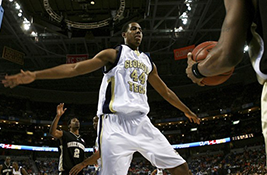February 4, 2020

Inbounding the Ball Under Pressure
Vital Importance, Under Pressure, Techniques & Principles, Receiving, Rules, Knowledge Quiz
Many of big games and championships have been lost because teams were not able to inbound ball at end of game. It is not easy to inbound ball, especially at the end of a game when the outcome depends on it. Players on all levels, including the professional ranks, need to know and practice the fundamental skills and techniques required in making a successful inbound pass.
Do not take inbounding the ball for granted
Most coaches and players take making an inbounds pass for granted, and rely on individual player skill to get the job done. However, in making an inbounds pass, the passer is facing a five against four defensive advantage and only has five (5) seconds in which to locate a receiver and make a successful inbounds pass. In addition, to this numerical disadvantage, by rule the inbounder cannot move, except after a made shot. This provides the defense with the opportunity to jam or smother the passer very effectively with an active defender on ball. Also, on baseline and endline out of bound situations, the backboard comes into play and becomes a real obstacle in which that the inbounds passer has to contend.
Good inbounders are vital, and a team will not win a championship without one.

Good inbound passers are hard to find. They must be developed & nourished. In additional to the physical skills involved, good inbound passers must posssess a strong commitment to team play since they are taken for granted and very rarely acknowledge for the efforts.
Note: Guy Lewis, who led the University of Houston to five final fours, thought that inbounding the ball was so important that he employed a designated inbounder. Every time Houston was awarded the ball out of bounds, the designated inbounder would enter the game and then leave on the next dead ball.
Techniques and Principles
- Inbounder must wait for teammates to be aligned and ready before stepping out of bounds.
- Call out of bounds plays prior to stepping out of bounds and receiving the ball from the official. Establish eye contact, and echo the call.
- See the floor prior to obtaining the ball. Circle to the official (or ball after a made basket) viewing entire court. Never step out of bounds to inbound the ball with back to the court. This is especially true after an opponent’s successful layup on a breakaway.
- Anticipate, read and attack any defensive overplays and errors. If defense switches on a screen look for the screener rolling to be open.
- Use sharp, crisp passes. No careless, one-handed or soft bounce passes.
- Avoid inbounding the ball into a corner (trap zone) unless an open shot is immediately available.
- Pass the ball through, not over, the defender pressuring the inbounds pass. If the defender’s hands are up. Fake high and pass under their arm pits. If the defender’s hands are down, fake down and pass the ball close to their ear.
- Be sure to step inbounds after inbounding the ball. Create a lead for return pass, establish offensive rebounding position or maintain defensive balance.
- AUTOMATIC: Whenever unguarded, execute a “Give & Go” cut. Inbound the ball and receive the ball back on a basket cut.
- AUTOMATIC: When the defender guarding the out of bounds pass turns their back to the passer, the inbounds passer can pass to themselves by throwing the ball off the opponent, stepping inbounds, and retrieving it. This can catch the defense completely by surprise and create an easy shot.
CAUTION: When in trouble throw ball out of bounds off an opponent’s leg or take the five (5) second inbounds violation rather than throw the ball away. When the ball is turned over on the inbounds pass, it immediately creates a five-on-four offensive advantage. However, by taking the five (5) second count, it will allow a team to get set on defense and have better than 60% chance of making a defensive stop.
Executing Long Passes
To be successful, the basic technique of throwing and leading receivers with long baseball passes must be taught and practiced regularly.
Inbounding the Ball Full Court
- When inbounding the ball, make as deep as an inbounds pass as the defense will allow. This will cut down the time and distance needed to advance the basketball and attack the defense.
- Whenever possible, inbound the ball to a player in motion.
- When taking the ball out of bounds after a made basket or free throw, take the ball out on one side of the backboard to avoid striking it on long passes.
- Never throw a pass directly to a receiver moving away. Since the receiver will be looking back at the ball, the defender can easily establish defensive position resulting in leading the receiver into offensive foul or traveling violation.
- On long passes, always lead the receiver to the “Elbow” eliminating the need of dribbling which allows defenders to catch up. If the pass is thrown too far out in front of the receiver, when it hits the floor, because of the back spin, it will bounce straight up allowing the receiver to catch up and gain possession rather than skipping out of bounds.
- Employ an “Over the Top” baseball pass or a hook pass. A high arching pass will not only allow the defense to recover, but it also may hit an obstruction hanging down from the ceiling such as the scoreboard or speaker.
Proven Full Court Out of Bounds Plays: Click Here
Successfully Receiving an Inbounds Pass
Inbounding the ball requires timing and execution on the part of both the passer and receiver. Timing is crucial. Creating a lead is of little value, if it is too early or too late.
Five basic techniques for getting open to receive an inbounds pass: Click Here
Coaching Tip: Press Break
Basketball is a game of habits. When scrimmaging full court in practice, when taking the ball out of bounds after a made basket or free throw the offensive team should execute their press break at all times whether the defense is pressing or not. This will result in the team being prepared and conditioned for presses and eliminate ever getting surprise by an opponent press.
All Players Must Know the Rules
Do not take rule knowledge for granted. A player’s lack of rule knowledge cannot only result in a loss of ball possession, but can also cost you a game.
- On a throw-in the ball must leave the inbounders hands within five seconds from the time the throw-in starts.
- For a timeout to be granted during the throw-in, it must be requested before the five second count elapses. Make sure all players know how many time outs they have left in the game.
- Except after a made shot, the inbounder is allowed one step in either direction from the designated throw-in spot.
- After a made shot, the inbounder can run along the baseline prior to making an inbounds pass.
- On the throw-in after a made basket, you do not lose right to run baseline because of an infraction by defense. If the ball is kicked by a defender, the inbounds passer can still run the baseline on subsequent throw-in.
- The inbounder cannot touch the ball until it has been touched by another player.
- If the defender plays with their back to inbounder, the inbounder can toss the ball off the defender’s back as long as, they must step inbounds prior to picking up the ball and shooting.
- Cannot not change the inbounder once an official has designated player for throw-in.
- From the front court, an inbounder can safely pass the ball into the back court without an over and back violation being called.
- Inbounder cannot throw ball over the backboard or directly into the basket. Note: Prior to rule change, teams with a tall player could simply lob the ball over the basket. Coaches would use their creative ingenuity, including hanging chicken wire down from the ceiling behind the basket, to stop out of bounds lob plays.
- After a made basket, if ungarded, the inbounder can pass to a teammate stepping out of bounds on the baseline and receive a pass back after stepping inbounds.
- If the defender reaches over the out of bounds vertical plane and touches the ball while in the hands of the inbounder or is in the air behind the vertical plane, it is a technical foul.
- When the inbounds pass goes directly out of bounds, it comes back to the original throw-in spot rather than where it goes out of bounds.
- When a timeout is called immediately following a made basket, on the subsequent throw-in the inbounder can still move along the baseline.
Test Your Players’ Out of Bounds Rule Knowledge
HoopTactics’ Self-Quiz (Printable) – Click Here
Give this self -test to your players. Don’t assume that they know the rules. Use the results as a team evaluation. Go over any question(s) missed by multiple players making sure that all players understand the rule. In taking a few minutes to test your players’ rule knowledge, it may save and even win a game or two.
CAUTION: Do not ever expect your players to execute anything during a game that you have not covered in practice.
Posted: February 4th, 2020 under Coaching Strategies | Defensive Strategies | Game Strategies | Offensive Strategies | Player Development | Practice Strategies.
Tags: full court, Inbounding Ball, offensive fundamentals, Passing, pressure, receiving, Rules


